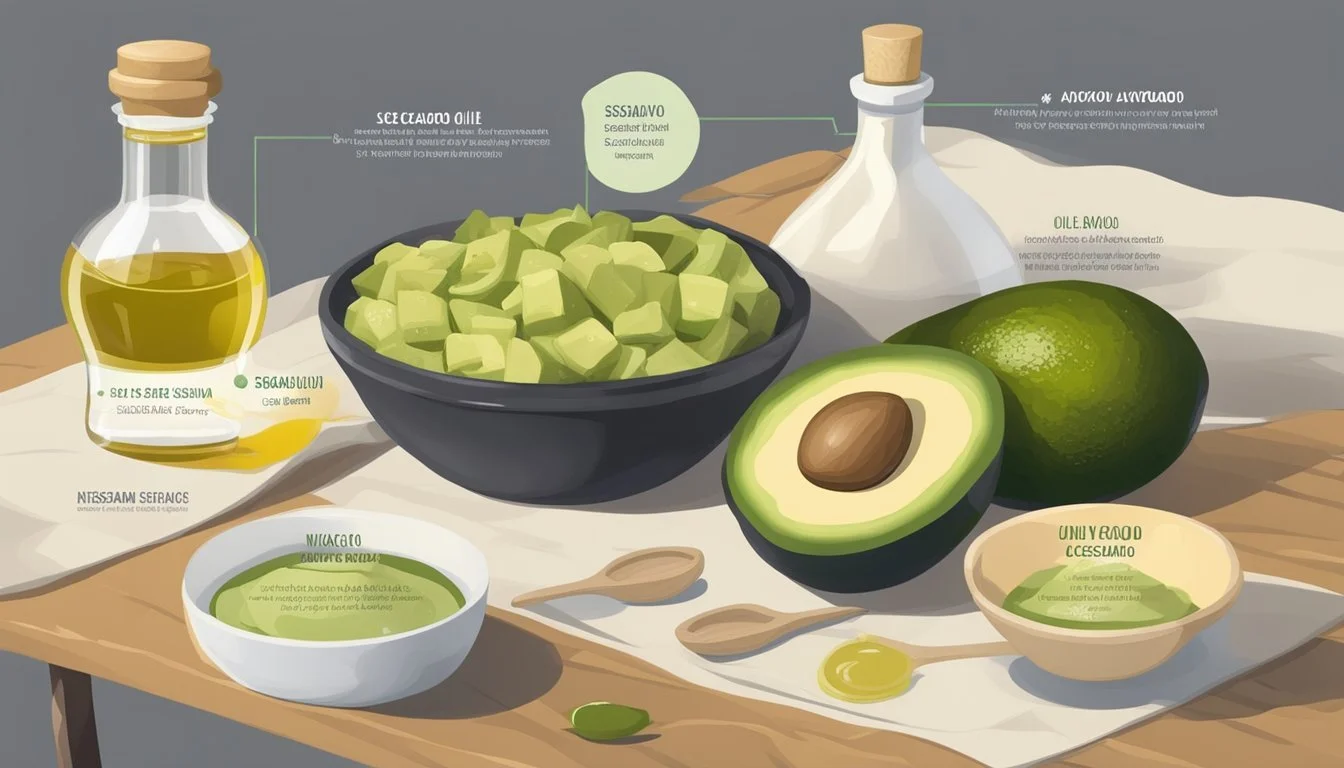Sesame Oil Substitutes
Top Alternatives for Cooking and Dressing
Sesame oil, with its distinct flavor and aroma, is a staple ingredient in many cuisines, especially Asian dishes. However, there are instances when one might need to find a substitute for this oil, whether due to allergies, dietary preferences, or simply running out of it in the kitchen. A variety of other oils can be used as alternatives, which often aim to mimic or complement the unique nutty taste and cooking properties of sesame oil.
While toasted sesame oil is typically used for its potent flavor, regular, untoasted sesame oil is preferred for its higher smoke point, making it suitable for frying and sautéing. When substituting for toasted sesame oil, it's beneficial to choose oils with a similar robust flavor, such as walnut or avocado oil. On the other hand, for untoasted sesame oil, options like grapeseed, canola, and vegetable oils are suitable due to their neutral taste and versatility in cooking.
Understanding Sesame Oil
Sesame oil, derived from sesame seeds, is a vegetable oil that comes in various types, each with distinct characteristics. Toasted sesame oil, also known as dark sesame oil, is crafted from toasted sesame seeds. It imparts a strong, nutty flavor and is a staple in Asian cuisines, often used as a flavoring element rather than a cooking oil due to its low smoke point.
Untoasted sesame oil, sometimes referred to as light sesame oil or regular sesame oil, is made from raw sesame seeds and retains a lighter color and more neutral taste. Its higher smoke point makes it suitable for cooking applications like frying and sautéing.
Types of Sesame Oil Sesame Seed State Flavor Profile Culinary Uses Light or Regular Raw or Untoasted Neutral General cooking, frying Dark or Toasted Roasted or Toasted Rich and Nutty Seasoning, dressings
Extra virgin sesame oil is a term less commonly used but implies a cold-pressed method retaining most nutrients and flavor. In contrast, black sesame oil, produced from black sesame seeds, may offer a different flavor profile and is less common in stores.
Sesame oil is not only valued for its flavor but also for its nutritional content, including a healthy dose of fatty acids. Buyers should consider each oil's unique flavor and heat tolerance when choosing a sesame oil for culinary purposes.
Importance of Sesame Oil in Cuisine
Sesame oil is a staple in Asian and Middle Eastern cuisines, cherished for its nutty flavor and aromatic essence. In Korean cuisine, for example, it is a fundamental ingredient that imbues dishes with a distinctive taste. This oil is utilized in a variety of culinary applications ranging from cooking to finishing touches.
Cooking: Sesame oil's relatively high smoke point, especially in its toasted form, makes it suitable for frying and stir-fry preparations. Its ability to withstand heat allows it to create delectable textures and add a layer of flavor.
Dressings and Sauces: Its rich taste is prized in dressings for salads, where subtle flavors are important. Sesame oil can be whisked into sauces and marinades, contributing a depth of flavor that's hard to duplicate with other oils.
Baking: Although less common, sesame oil can also be used in baking to lend a unique twist to traditional recipes.
Culinary Variety: While other cooking oils mainly serve a purpose in preparing a dish, sesame oil often plays a dual role as both a key cooking medium and a flavor enhancer.
In both raw and cooked forms, sesame oil offers a versatility that is utilized across a broad spectrum of dishes. Whether incorporated into a medley of flavors in a stir-fry, drizzled over finished dishes, or used to grace salad dressings, its importance in elevating the taste profile of a meal cannot be overstated. For those engaging in deep-frying, sesame oil provides a tasty alternative that also contributes its heart-healthy fats to the cuisine.
Health Aspects of Sesame Oil
Sesame oil has gained recognition for its nutritional profile and potential health benefits. Rich in antioxidants, it is known to combat oxidative stress which can lead to chronic diseases. The oil's antioxidant content is principally due to the presence of compounds such as sesamol and sesamin.
In terms of vitamins and minerals, sesame oil contains a notable amount of vitamin E, contributing to its stability and shelf life, but also providing health benefits such as improved skin health. This, alongside other antioxidants, might help in protecting against heart disease. Vitamin E plays a role in immune function and acts as a natural anti-inflammatory agent.
Nutrient Benefit in Sesame Oil Monounsaturated fats Support heart health Polyunsaturated fats Improve blood lipid profiles Omega-3 fatty acids Reduce inflammation Magnesium Support muscular and nerve function Zinc Aid in immune system function
These fatty acids, specifically monounsaturated and polyunsaturated fats, are known for their ability to improve lipid profiles and reduce low-density lipoprotein (LDL) levels in the blood, which could lower the risk of heart disease. Omega-3 fatty acids in sesame oil also contribute to the oil's anti-inflammatory properties that may help manage conditions such as arthritis.
Sesame oil, esteemed for its healthy fats, is considered a relatively healthy oil and can fit well within a balanced diet. However, it should be consumed in moderation due to its high caloric density.
Choosing a Sesame Oil Substitute
When the distinctive, nutty aroma of sesame oil is desired but unavailable, identifying an appropriate alternative hinges on the intended use—be it for garnishing or cooking. Sesame oil is often utilized as a finishing oil, imparting an earthy, slightly bitter flavor to dishes.
For Garnishing or as a Dressing: A substitute should complement the flavor profile of the dish without overpowering it. Here are a few suitable options:
Avocado Oil: With its high smoke point and neutral taste, it adeptly serves in place of sesame oil for dishes requiring high heat.
Walnut Oil: This oil offers a nutty flavor and is best suited for cold dishes, such as dressings and marinades, due to its low smoke point.
For Cooking: In terms of cooking oils, the smoke point becomes a critical factor:
Peanut Oil: A common cooking oil with a high smoke point and subtle flavor, making it a versatile substitute for sesame oil.
Vegetable Oils: A range of oils—such as canola, sunflower, and safflower—provide a neutral flavor and are viable alternatives, especially in recipes where the distinctive taste of sesame is not central.
To replicate sesame oil’s unique taste, one might consider a homemade mixture:
Lightly toast sesame seeds to release their essential oils.
Blend the toasted seeds with a neutral oil, like canola or sunflower, in a 1:4 ratio of seeds to oil.
This concoction can be used as a substitute in sauces and dressings where sesame oil's signature flavor is desired. Remember, the flavor strength and texture of the substitute will vary from the original, so adjustments should be made according to taste and desired outcome.
Substitutes Based on Flavor Profile
Selecting a substitute for sesame oil hinges on matching its distinctive flavor profile, which is often described as nutty and earthy. This section explores various oils that can mimic these characteristics, ideal for dressings, marinades, and sauces.
Nut Oils and Their Characteristics
Walnut Oil: Known for its nutty essence, walnut oil serves as an apt sesame oil substitute particularly in salad dressings where its flavor can stand out. It is less suitable for high-heat cooking due to its low smoke point.
Roasted Peanut Oil: With a robust nutty flavor akin to sesame oil, it fits well in sauces and marinades and can be used in stir-frying at a 1:1 replacement ratio.
Almond Oil: Provides a milder nutty taste, making it a versatile ingredient in dressing and sauces. Almond oil's subtle flavor ensures it doesn't overpower dishes.
Seed Oils as Alternatives
Grapeseed Oil: It has a more neutral taste but can carry a slight earthiness, making it useful in dressings and light sautés where sesame oil's flavor isn't the star.
Sunflower Oil: Its mild taste won't clash with other ingredients, while its high smoke point allows it to adapt to various cooking methods that require sesame oil.
Hemp Seed Oil: Exhibits an earthy, nutty flavor, making it a nutritious sesame oil stand-in for cold applications like salad dressings.
Pumpkin Seed Oil: Delivers an earthy undertone reminiscent of sesame oil, ideal for drizzling over finished dishes or blending into dressings.
Other Substitutes with Unique Flavors
Avocado Oil: Although it has a different flavor profile, avocado oil's high smoke point renders it a suitable alternative for sesame oil in high-heat cooking. Its butteriness pairs well in dressings and marinades.
Coconut Oil: Its distinct flavor differs from sesame oil but can complement Asian-inspired dishes. Best reserved for specific recipes that can benefit from coconut oil's unique taste.
Olive Oil: Especially light olive oil, can be used for its fruity notes which, while different, can still provide a pleasant flavor in dressings and low-heat cooking dishes.
Substitutes Based on Usage
When replacing sesame oil, it's crucial to consider the cooking method and the dish's flavor profile. The smoke point of an oil and its flavor will determine if it suits high-heat applications or should be used cold to maintain its essence.
High-Heat Cooking Applications
For dishes that require cooking at high temperatures, such as frying, sautéing, and stir-frying, oils with a high smoke point are essential. This ensures that the oil doesn't break down and release harmful compounds, maintaining the food's flavor and nutritional value.
Avocado Oil: With a smoke point surpassing 500°F, avocado oil is ideal for high-heat cooking. It is suitable for frying rice or for use in a stir-fry, offering a neutral flavor when heated.
Peanut Oil: Often used in Asian cuisine, peanut oil is another substitute with a high smoke point, around 450°F. It provides a nutty flavor suitable for sautéing and deep-frying.
Canola Oil: A versatile oil with a high smoke point of about 400°F, canola is a good option for various cooking methods, including frying and sautéing.
Grapeseed Oil: It has a moderately high smoke point of approximately 420°F, making it fit for most high-heat cooking needs.
Oils like extra virgin olive oil and butter have lower smoke points and are not recommended for high-temperature cooking.
Cold Uses and Finishing Oils
When it comes to dressings, sauces, or adding a finishing touch to dishes, oils used should complement the dish's flavors without overpowering them.
Light Olive Oil: Milder than its extra virgin counterpart, light olive oil can be used in salad dressings or as a finishing oil.
Flaxseed Oil: Due to its nutty flavor, this oil can replace sesame oil in uncooked dishes. It should not be heated, as it has a low smoke point.
Walnut and Pumpkin Seed Oils: These oils add a distinct taste to finished dishes or dressings and are best used raw to preserve their flavors.
Cold-pressed sesame oil is traditionally used for its potent flavor; hence, milder oils like sunflower or vegetable oil can be infused with toasted sesame seeds to replicate the taste without the need for heat.
Making Homemade Sesame Oil
When a recipe calls for sesame oil and you find yourself without, creating a homemade version is a practical solution. One can opt for toasted or untoasted sesame seeds depending on the flavor intensity desired. Toasted sesame seeds yield a richer, deeper flavor, while untoasted seeds provide a subtler touch.
Ingredients:
1 cup of a neutral oil (e.g., canola oil or vegetable oil)
1/4 cup of sesame seeds (toasted or untoasted)
Instructions:
Prepare the Sesame Seeds: If using untoasted seeds, begin by spreading them in a single layer on a baking sheet. Toast them in a preheated oven at 350°F (175°C) until golden brown, usually around 5-10 minutes. Monitor closely to avoid burning.
Heat the Oil: Pour the oil into a skillet and add the toasted or untoasted sesame seeds.
Infuse the Oil: Heat the mixture on low heat, stirring occasionally, until the seeds brown—this typically takes around 5 minutes for toasted seeds, a bit longer for raw seeds. Ensure the seeds do not burn, as this will impart a bitter flavor.
Cool and Blend: Allow the oil to cool. Transfer the mixture to a blender and blend until smooth.
Strain: Using a fine mesh sieve or cheesecloth, strain the oil into a clean container to remove the solid particles.
Store: Keep the homemade sesame oil in an airtight container. If using toasted seeds, the oil will have a more potent flavor and a darker color, resembling that of commercial sesame oil. Store in a cool, dark place.
The ratio of oil to seeds ensures the resulting flavor is not overwhelmingly strong, makes this homemade oil suitable for a variety of dishes that call for sesame oil.
Nutritional Comparison of Substitutes
When considering substitutes for sesame oil, it's important to assess the nutritional profile of potential alternatives. Sesame oil is known for its healthy fats and vitamin E content. Here's how other oils compare:
Olive Oil: Olive oil is celebrated for its monounsaturated fats, namely oleic acid, which can support heart health. Rich in antioxidants, it provides a robust amount of vitamin E and polyphenols.
Avocado Oil: Like olive oil, avocado oil is high in monounsaturated fats and vitamin E. It also contains polyunsaturated fats, including omega-3 fatty acids, though in smaller quantities compared to sesame oil.
Canola Oil: Canola oil features a lower amount of saturated fat and higher levels of omega-3 fatty acids than most vegetable oils. It is also a decent source of vitamin E, although less concentrated than sesame oil.
Coconut Oil: Coconut oil is known for its high saturated fat content. It's less rich in polyunsaturated and monounsaturated fats. It has a different nutrient profile, lacking significant omega-3 fatty acids, and is relatively low in vitamin E.
Grapeseed Oil: This oil is high in polyunsaturated fats, particularly omega-6 fatty acids, and contains a good amount of vitamin E. Grapeseed oil's omega-6 to omega-3 ratio is less favorable compared to sesame oil.
Nut and Seed Oils: Nut oils like walnut or almond oil are typically high in polyunsaturated fats and have a good dose of omega-3 fatty acids. Seed oils, such as sunflower oil, are also high in vitamin E but may contain more omega-6 than omega-3.
Vegetable Oil: Generic vegetable oils may vary in composition but often have a mix of polyunsaturated, monounsaturated, and saturated fats. They are versatile but may not offer the same concentration of omega-3s or vitamin E as sesame oil.
In summary, while all these oils contribute dietary fats, the ratios of saturated, monounsaturated, and polyunsaturated fats differ, as does their vitamin E content and presence of omega-3 fatty acids. Consumers should choose oil that best aligns with their dietary needs and cooking applications.
Allergy Considerations and Sesame Oil Alternatives
When dealing with food allergies, especially to sesame oil, individuals must be vigilant in selecting alternatives that do not trigger allergic reactions. Sesame allergies are prevalent and can cause serious health concerns for those affected. Therefore, exploring safe substitutes for sesame oil is critical for allergy sufferers.
Nut Oils and Peanut Oil: These are common replacements for sesame oil in cooking, but can be problematic for those with nut allergies. Peanut oil, while popular for its neutral taste and high smoke point, is particularly risky for individuals with peanut allergies.
Safe Alternatives: For those looking to avoid allergens, there are several non-nut-based oils that can act as substitutes.
Avocado Oil: This is a suitable sesame oil alternative due to its high smoke point, making it perfect for high-heat cooking. It is safe for those with sesame and nut allergies.
Sunflower Oil: Another allergen-friendly option, sunflower oil has a mild flavor and can be used in a similar fashion to sesame oil.
Table of Allergen-Friendly Sesame Oil Substitutes:
Alternative Oil Considerations Smoke Point Avocado Oil Nut-free, Sesame-free High Sunflower Oil Nut-free, Sesame-free Medium-High
These alternatives must be considered in the context of each person's dietary restrictions and allergy considerations. When introducing a new oil as a substitute, individuals should ensure that it does not cross-react with sesame or other allergens they are sensitive to. It's always wise to consult with a healthcare provider before making dietary changes related to allergies.
Culinary Applications of Substitutes
When sesame oil is unavailable, a variety of oils can be utilized to maintain the integrity of the dish. The selection of an appropriate substitute is dependent on the specific culinary application.
For Sauces and Marinades:
Walnut oil, despite its low smoke point, imparts a rich, nutty essence suitable for salad dressings and marinades.
Avocado oil, with its high smoke point, is versatile for dressings and can be used in high-heat applications.
In Stir-frys and Frying:
Avocado oil is again a reliable option due to its high smoke point, ensuring foods are cooked evenly without the risk of burning.
Peanut oil is a staple in Asian and Korean cooking, known for its high smoke point and mild flavor, perfect for frying and stir-frys.
For Baking and Middle Eastern Cuisine:
Neutral oils, such as safflower, are ideal for baking, giving moisture without overpowering other ingredients.
Vegetable oils like canola or sunflower also blend seamlessly into various dishes, favored for their versatility.
Example Usage in Cooking Styles:
Asian Cooking: Peanut oil or vegetable oil.
Korean Cuisine: Toasted sesame seeds with vegetable oil.
Middle Eastern Cuisine: Neutral oils like safflower.
In Summary:
Application Substitute Note Salad Dressings Walnut Oil Use for its nutty flavor; avoid high heat. Stir-Fry Peanut Oil Ideal for high heat and neutral taste. Baking Safflower Oil Light, high smoke point perfect for baked goods. Asian Cooking Vegetable Oils Variety of oils available to match sesame oil’s role. Marinades Avocado Oil High smoke point and subtly enhances flavors.
It’s essential to match the oil's attributes with the cooking method to achieve the best results.







